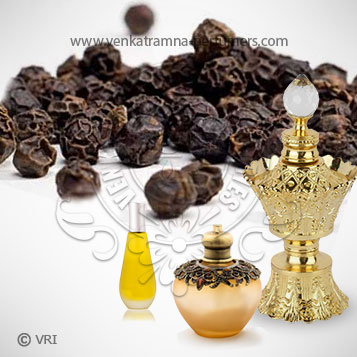
| Botanical Name | Piper nigrum |
| Common Name | Black Pepper, Piper (United States Pharmacopceia) |
| Country of Origin | India |
| Solubility | soluble in water, insoluble in oil |
| Specific Gravity | 0.853 – 0.880 @ 25 Deg. C |
| Optical Rotation | -1.0 – -26 @ 20°C |
| Refrective Index | 1.478 – 1.488 @ 25 Deg. C |
| PlantPart | Leaves |
| Bland With | Bergamot, Clary Sage, Lavender, Geranium, Jasmine, Neroli, Patchouli, Tea Tree, Rose, Lemon and Ylang-ylang. |
| CAS No | 84929-41-9 |
| Flash Point | 215°F |
| Extraction Method | Steam Distilled |
The oleoresin is obtained from properly ripened seeds of black pepper. Dried peppercorns are completely processed with the blackened external covering. The extraction is performed by percolating with variety of solvents, primarily hexane, which are removed prior to use. Black pepper oleoresins have heavier flavor and is far more popular than other varieties.
The origin is basically India. Black Pepper is found mostly is southwest India but other countries known for its cultivation are Malaysia, China and Indonesia. The plant grows up to 16 feet in height and has heart-shaped small leaves and requires extreme care. It has white flowers which blossom into small, round fruits.
Color : yellowish brown viscous liquid with pungent slightly biting aroma of Black Pepper,
Aroma : Its aroma is strong, sharp and spicy. It resembles clove oil.
Volatile oil content v/w : 20 ml/100gm Piperine content : 40% Residual solvent (By gas chromotography): Less than 10 ppm
Black pepper oleoresin is widely used in food industry as a coloring and flavoring agent. The oleresins represent complete spice flavor whereas essential oils only the aroma.